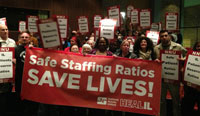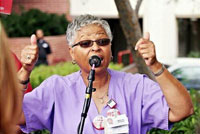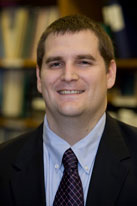Health experts debate the merits of nurse-staffing ratio law
A hospital’s patients will be better off when there are more experienced nurses to tend to them—all health experts agree with that. But just how many nurses should there be? Is there an ideal patient-nurse ratio? And should we require hospitals to strive for it? These are all points of ongoing debate.

The National Nurses United Chicago Chapter rally for a nurse-staff ratio law at a town hall meeting in Chicago. Photo: National Nurses United
Hospitals across the country have growing caseloads of patients and limited numbers of nurses available to treat them—the consequence of 20 years of hospital downsizing due to state budget cuts and private mergers. There are fewer nurses, all working longer hours and rushing through more patients during every shift, as a result. A survey of nurses by the American Nurses Association found 54% saying that they did not have sufficient time to spend on each patient, despite 43% of the respondents working longer hours during the prior year.
A Nurse Staffing Ratio Law
In 2004, California began implementing a law requiring all of its hospitals to limit the numbers of patients that its nurses could treat at any given time. The limits would vary depending on the hospital setting. For instance, the ratio in an operating room can’t exceed one nurse for every one patient, while a psychiatric ward can have up to six patients for every nurse, and pediatric and emergency-room units can have up to four patients per nurse.
The California Department of Health Services had arrived at these ratios following a year of consultations with researchers from the University of California-Davis Medical Center, who based their recommendations on surveys they had personally conducted of nurse directors throughout the state. Expert opinion combined with a sweep of existing real-life perspectives from the hospitals themselves, and the California law’s mandated ratio numbers were the end result.
To ask some nurses, the law was a godsend. Before it went into effect, some had as many as 10 or more patients to tend to at a time on every shift. They would wear themselves out trying to diagnose and treat each one. Every working shift was rushed and exhausting, and simple mistakes or missed cues became more common than they needed to be, inevitable side effects of nurses going on too much stress and too little sleep.
“I didn’t have enough feet, enough hands, to get the work done,” said Millicent Borland, a staff nurse at Summit Hospital in San Francisco.

Millicent Borland speaking at a strike over staffing levels.
Photo credit: D. Ross Cameron/The Oakland Tribune
Bringing the inflows of patients down to a more measured pace brought about a multitude of positive improvements, according to the nurses’ union National Nurses United. Citing surveys and nurse testimonials, the union attests that the no-longer-overworked nurses gained newfound time to give to each patient, and even time to give themselves occasional needed breaks. While their hours stayed the same, patients gained as much as an hour or more of their nurses’ time each day. Procedural mistakes declined. And outcomes improved: Fewer patients got sick in the hospital, more recovered, and fewer had to return because of post-treatment complications.
“It gives me the time to look at their chart and look at the doctor’s progress notes, so I can see the big picture of what’s going on with the patient,” said Stephanie Crowe Patten, a registered nurse at Alta Bates Summit Medical Center in Berkeley.
The Cost of Change
But the change came at a price. A hospital clearly can’t up the ratio of nurses to patients unless it first hires more nurses. Starting in 2004, then-Gov. Arnold Schwarzenegger enacted a major boost in funding for nurse education programs. Hospital systems, for their part, upped nurses’ salaries and benefits so as to attract and keep more nurses. As of today, the average California nurse’s salary has risen to $100,000 plus benefits, according to the California Hospital Association.
The investments worked, and within several years, the number of registered nurses in California grew by 125,000. But as one can imagine, it’s been an expensive success.
“It means that you’re spending a lot more money. You’re adding to the overall costs of the health care system,” said Jan Emerson-Shea, vice-president of external affairs for the California Hospital Association.
Will there be more states following suit?
Nearly a decade later, California is still the only state to have enacted a nurse-staff ratio law. But nurse unions in other states are pressing their lawmakers to follow suit. Six more states—Florida, Iowa, Minnesota, New Jersey, New York, and Texas—and the District of Columbia are now considering enacting nurse ratio laws of their own.
They have several allies in the U.S. Congress, too. The National Nursing Shortage Reform and Patient Advocacy Act, which Sen. Barbara Boxer (D-California) introduced in April 2013, would require hospitals to maintain minimum ratios of nurses to patients and would impose audits and fines on the hospitals whose ratios fall too low. Rep. Jan Schankowsky (D-Illinois) introduced a related bill, the Safe Nurse Staffing for Patient Safety and Quality Care Act, to the House of Representatives in May 2013.
What the Hospitals are Saying
There is fierce opposition, however, from the hospital executives. Hospital associations protest that the laws would impose steep fiscal costs on them and would deprive hospital administrations of the right to make staffing decisions about their own wards.

Jan Emerson-Shea, vice-president of external affairs for the California Hospital Association
Jan Emerson-Shea, vice-president of external affairs for the California Hospital Association, seconds her fellow hospital-association leaders’ objections. It’s impractical for any hospital to keep the ratio of nurses to patients within a set limit, she argues, with all the inevitable ups and downs of hospital life—a disaster or violent crime causing a sudden inrush of many patients needing urgent care, for instance, or a few nurses calling in sick on the same day.
In some cases, the ratio laws might even leave some patients waiting longer to be treated, she added. She gave the example of a nurse who’s got four patients in her ward and more waiting in the lobby. Of the four in the ward, perhaps two don’t actually need attention at that moment—one is on the way to get some imaging done and the other is simply waiting for a new bed to open up.
The nurse might want to step away from those two and bring in another one or two patients from the waiting room. But under the ratio law, she can’t. She’d be overstepping her limit. The patients in the waiting room just have to go on waiting.
“Hospitals are a really dynamic environment. You can’t plan for all these types of things,” Emerson-Shea said. “And they (the nurse-staff ratio laws) don’t allow you to flex up and down according to what the needs of your hospital are.”
Given the large fiscal investments that California had to make in order for its nurse-staff ratio law to work, it’s perhaps not surprising that many state governments have been reticent about adopting California’s law. Add to that the heavy fiscal pressures that many states are facing now just to implement the reforms of the Obama administration’s 2010 health-care reforms, Emerson-Shea notes—setting up health-care exchanges, enrolling millions more residents of each state into insurance programs, and other stipulated actions of the health-care law. She doubts that any state will be interested in taking up the challenge of nurse-staff ratio reforms, as well.
“We’ve kind of adjusted, but I would find it difficult to think that a lot of states will move in this direction,” she said.
Hope May Be Found in Nursing Education
There may be hope in education, however. Matthew McHugh, associate professor of nursing and Robert Woods Johnson Foundation Nurse Faculty Scholar at the University of Pennsylvania School of Nursing, notes that the nation’s health-care systems have recently been encouraging more nurses to pursue bachelor’s degrees or master’s degrees. The National Academy of Sciences’ report “The Future of Nursing” concurs and calls for 80% of nurses to have bachelor’s degrees or higher by 2020, up from the approximately 35% that have reached that level of learning today.
McHugh supports that goal. Better-trained nurses will work better and achieve better patient outcomes even if they are challenged with large caseloads of patients, he explained.

Matthew D McHugh, PhD, JD, MPH, RN, CRNP, FAAN
“There is some emerging evidence that it can’t all be about the numbers. We know, for instance, that if you have a better-educated work force, that’s a better way to improve your quality of care even if your numbers are a bit lower,” McHugh said.
Raising nurses’ standing in the hospital settings would also be a help, he added. Hospitals can give nurses more decision-making power and more workplace parity relative to the doctors. And this may translate to those nurses having higher morale and, by extension, putting in stronger job performance.
“I think we’re getting more sophisticated in our understanding of how we can get more out of the nurses that we have,” he said.
That’s not to say that nurse-staff ratios don’t matter, though. McHugh noted that even the best-trained, most enthusiastic nurses will wear out if they are forced to tend to too many patients day after day.
More Ratios
But there is another ratio that causes McHugh even greater concern. And that’s the ratio of nurse educators to potential nursing students. If the United States wants more nurses, and ultimately a better nurse-to-patient ratio, then the first place to start would be upping the enrollment and training of student nurses. That has a prerequisite, of course: more nurse faculty.
“I think this recommendation that more nurses get bachelor’s degrees, it’s not just a way to get good care and improve patient outcomes but more of these nurses can go on to fill faculty positions. And that’s really where the bottleneck is,” McHugh said. “If you don’t have the manpower to do the training, all those university buildings would just sit empty anyway.”
Alleviating Pressure on Hospitals via Secondary Health Care Facilities
McHugh also finds hope in the growing utilization of other health facilities besides hospitals. Many patients with minor health needs, such as flu shots or blood-pressure checkups, are now going to local “retail clinics”—so named because they’re found at retail outlets such as pharmacies—and reserving hospitals for more serious conditions. This is a great way to allocate health care more efficiently and thereby relieve some of the pressure on the hospitals, McHugh said.
“There is a place for the hospital and there’s a time. But you want to make sure that it’s used appropriately and that there are alternatives out there so that patients who don’t need hospital care can get their needs met at places outside the hospital,” he said.
Legislation and Other Reform
Other states have passed legislation relating to nurse-staff ratios, too, but not by prescribing set ratios like California has, he also noted. For example, seven states—Connecticut, Illinois, Nevada, Ohio, Oregon, Texas, and Washington—now require hospitals to have formal written policies on staffing and patient caseloads. This can potentially avoid nurse overloading, since hospitals that plan ahead for busy days and staff absences will be less overwhelmed when the congestion happens.
Illinois also requires hospitals to publicly disclose their nurse-staff ratios, as do New Jersey, Rhode Island, New York, and Vermont. This can reduce overcrowding by letting patients and nurses know which hospitals are the most crowded, the result of which will be some of the less-crowded hospitals getting more new patients and more nursing job applicants.
“If the nurses are able to identify the hospitals with the better nurse staffing levels, those are the hospitals they will be more likely to work in. This could provide an impetus for those hospitals with worse nurse to patient ratios to improve their work settings and staff ratios,” McHugh said.
California being the only state to have implemented a nurse-staff ratio law, we can’t really tell whether such a law would be beneficial if implemented across the country, McHugh cautioned. But he strongly supports the goal of maximizing the numbers of well-trained nurses relative to patients. Through a number of reforms, including not only laws but also new clinics, better workplace management, and expanded education, healthcare systems everywhere can achieve better results for both nurses and patients.
“You can reach good outcomes by multiple pathways,” he said. “There is no cure all, but their overall aim is making more nurses available.”
Find Nursing Licensure Requirements in Your State:

Learn about becoming a Registered Nurse, LPN or LVN in your state:
To View Full U.S. Map Click Here.





